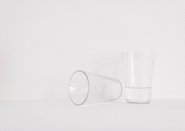Signs of Dehydration

There are many ways you can become dehydrated. Illness and blood loss are extreme examples, but the most common cause of dehydration is the failure to replace the water lost by our bodies. We lose water through sweat, urination, and even breathing. Exercise quickly depletes our bodies of water, as does walking outside on a hot day, or living in a warm climate. Any consumption of coffee or alcohol—even if moderate—also dehydrates our bodies, as these beverages are diuretics (substances that make us urinate more frequently).
Dehydration occurs a lot faster than one might think. If you lose just 2% of your body weight in water, you’re already mildly dehydrated. That means that, for example, if you’re 160 pounds, and your body is lacking 3.2 pounds of water, you are dehydrated. That’s about one and half litres. If you consider how often we go to the bathroom, plus how much we sweat and talk, it sounds pretty easy to get dehydrated, doesn’t it?
A great way to test if you’re dehydrated is the Skin Test. Pinch the skin on the back of your hand, and pull it upwards. Then, let go of the skin and see how long it takes for the skin to return to normal. If it snaps back immediately, you’re well hydrated. But if your skin takes a few seconds to go down, it’s likely that you need to drink more water.
But is dehydration really that bad? Yes. For starters, it will prevent your body from functioning normally. All of our organs and muscles (especially our brain) depend on adequate hydration. We need water to digest food and absorb nutrients, to lubricate our joints, to keep our blood pressure and temperature stable, and to help us think clearly. If we are always dehydrated, our bodies eventually become used to being without water, and we live each day below a standard of health to which our bodies require, and are capable of.
A secondary result of dehydration is its symptoms. Even though our bodies can partially adapt to being dehydrated, there comes a point where our brain starts sending us signals to drink more water. These signals usually arise in pain, discomfort, or ailments. If you are mildly dehydrated (remember, 2%), these might be some of your symptoms:
-Thirst
-Fatigue / Tiredness
-Headaches
-Bad breath
-Dry skin
-Overeating / hunger
-Yellow urine / less bathroom breaks
-Head rushes
-Dizziness
Have you ever had a headache that took days to go away? Or felt abnormally tired? If so, it’s likely those were signs of mild dehydration. If we fail to notice those signs, or choose to ignore them, eventually our bodies will become moderately dehydrated. The symptoms of moderate dehydration include:
-Nausea
-Feeling ill
-Increased Temperature
-Fainting
It seems like you’d have to be quite dehydrated in order to faint, but moderate dehydration occurs when we’ve only lost 4-5% of our weight in water. The repercussions of moderate dehydration aren’t fatal, but its vitally important to address these symptoms when they arise. If we don’t, we can become severely dehydrated, which happens when we’ve lost only 10% of our weight in water. As we all know, we cannot survive more than three days without water.
So then, how can you re-hydrate yourself and replenish the water you’ve lost? The answer is easy: drink more water. As simple as that sounds, it’s not enough to just drink lots of water anytime you get thirsty. Your goal should be to prevent dehydration, not reverse it. To do that, you need to intentionally hydrate throughout the day—every day. You also need to drink the right water.
Spring water is the best water you can drink, because your body needs fresh water to sustain itself. If you’re drinking tap water with potential pollutants, you’re doing your body more harm than good. Cedar Springs spring water is natural, free of chemicals, and bottled fresh from a protected, Canadian spring. It not only hydrates, but helps you stay hydrated. If we want to live the best life possible, we must prioritize hydration.


















